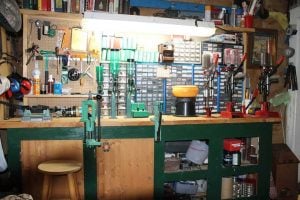
If you are thinking about reloading your own ammo, then I must tell you that it’s a good idea.
I don’t know your reason. I don’t know if you are doing it to save money or gain more control over your ammunition, but I can tell you that it’s a good idea.
If you are a professional shooter and want the best experience, then there’s no alternative to making your own bullets.
However, many don’t know much about the process. And a lack of knowledge here can be dangerous.
For this reason, in this post, I’m going to show you exactly how to reload your own ammo.
Here’s a step-by-step process for making your own bullets. I have tried to describe the process in the simplest manner so that anyone can follow it. So, even if you are a beginner who doesn’t know much about this stuff, you won’t have any problems acting upon the directions.
Working with deformed or dented cases is a recipe for failure. You don’t want to do that as there’s a lot of risks associated with that.
What you need to do is check the cases for dents and other deformities before you decide to use them. If you find them out of shape or problematic, set them aside as working with them can be hazardous.
What we do here is we use sizing die in the conjunctions with the help of a loading press. These reloading presses not only resize the case but also it presses out the old primers from the brass.
There’s always a risk of the bullet getting stuck. To prevent that, you gotta lubricate the case.
You need to get everything ready before getting started.
Also, make sure that you pull out the spent primers and insert new ones in their place. Yes, it’s not an easy process and is likely to consume hours, but it’s highly imperative that you do this thing with optimum care.
Now, this one is a tricky step. You have to measure the amount of powder carefully since powder requirement for each shell is different. If you haven’t done this before, then I’d suggests that you take help from a seasoned professional in this sector.
In addition, you can buy some books on reloading. That will help you to grasp the complexity of the process and enable you to do it in the right manner. One piece of advice that I will give you is that make sure you are loading the powder using only a funnel.
That will help you accomplish the task efficiently. And after you are done with powder reloading, store the remaining powder in a safe container. You don’t want the powder lying around the workspace as it can damage stuff. So, make sure that the workspace is free of powder.
First, you need to place the case carefully inside the shell holder. Then you will have to bring down the press handle a bit.
That will crimp the bullet case and also connect it with its lock ring. If you aren’t very familiar with crimping, you need to follow the guide provided by the manufacturer. Also, you need to decide how deep the bullet will sit and make changes with the seater accordingly.
Once you are done with the previous step, you need to divert your attention to dies and ram. Take a clean piece of cloth and wipe them clean. Then take gun oil and coat them with it.
Now that the process is over, it’s time to put place the bullets in cartridge boxes and tuck them away somewhere safe.
What if you didn’t like the method that I just described? Well, no worries, I have an equally efficient method for you. The reason that I am mentioning this method is that a lot of people find this method easier than the previous one.
So, if you are one of them, it will come in handy to you. So, without further due, let’s get to the process.
Here the step is pretty similar to the last method. You gotta inspect the empty cases very carefully and look for cracks and deformities. If you find any problem with it, then look for the next one.
No matter what, do not start the process with a faulty case.
Now, you will also have to see if the shell has reusable hulls.
But how to find reusable shells? Easy. Look closely at the mouth of this thing. If you see any kind of wear that is uniform and circular in shape, then it is a good candidate for the reloading process.
That said, if it seems to you that the wear is a bit too much, then you might want to do away with the shell. That’s because shells that are too worn down are unsuitable for crimping. So, if you stick with it, then you will only be wasting your time.
Also, discard the shells that are jammed. For they are known to result in faulty shells, and you should avoid them.
So, what are the ideal shells?
The ideal shells are the ones that you will find from break-open guns, which will permit you to remove the shells from the gun itself.
In order to remove spent primers, you can use a reloading machine. For that first you have to place the shell in the slot. After that, uncap the pin, which will remove the primer. In addition, it will modify the shell to the proper specifications.
And if there was some form of minor deformity, then it can also get fixed during the process.
Now, getting the load sizes right isn’t an easy task. Unless you have some kind of experience, you gonna have a hard time while measuring the sizes.
So, what you need to do is follow a manual that will guide through the process correctly.
I’d recommend that you get Alliant Guide, which is an amazing book and would be really helpful for you. The instructions inside the book are simple and easy to follow. They have described the instructions in a beginner-friendly manner to make it easier to understand.
Now it’s time for you to put primer and powder inside the shell with a reloader.
However, I need to warn you that each machine has a different working process meaning reading the manual before use is a must.
You’ll need to make use of the rotating plate to complete the process.
Next, you need to use the rotating plate again to install the plastic wadding.
For the final step, you need to crimp the shell. After doing that, store them in a safe place.
As you can see, the reloading process isn’t so daunting after all. But you have to remain careful all the time.
So, if you work with attentiveness, and follow all the directions properly, then I don’t see any reason for you to come across any problem. However, it needs practice and precision to come up with the best possible results.
Not only the precision will help but choosing the right equipment is also very important while you reload your own ammunition.
Go through some books and practice. This is what will provide you the best results while you load your ammunition by your own.

Joseph Fox writes on a variety of topics ranging from reloading ammunition to gun cleaning. He has been featured on various publications like thetruthaboutguns, Sofrep & many more. Joseph is also the founder of Gunloading, where he reviews different types of reloading & firearm products available on the market.
Gunloading.com is a participant in the Amazon Associates Program, an affiliate advertising program designed to provide a means for us to earn fees by linking to Amazon.com and affiliated sites.
About Us | Contact Us | Privacy Policy | Amazon Affiliate Disclosure
Copyright © 2022 Gunloading.com All Rights Reserved